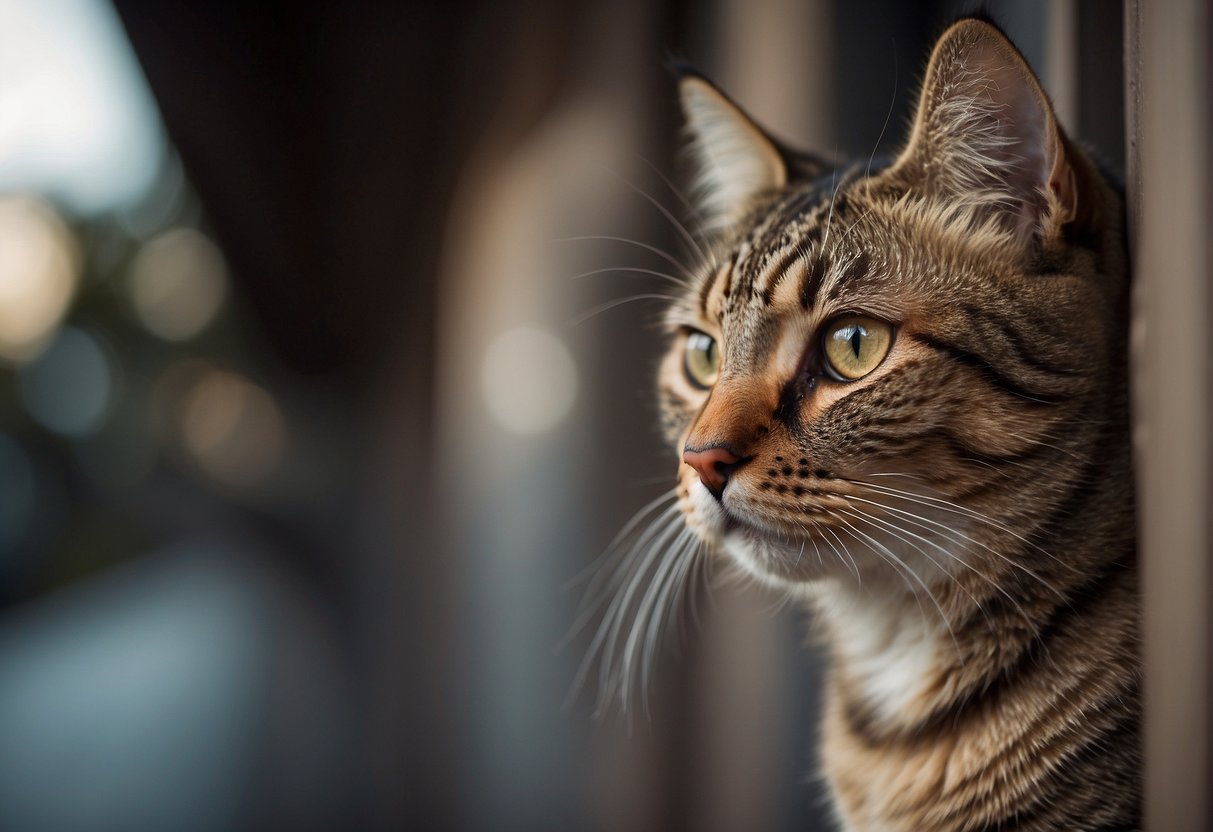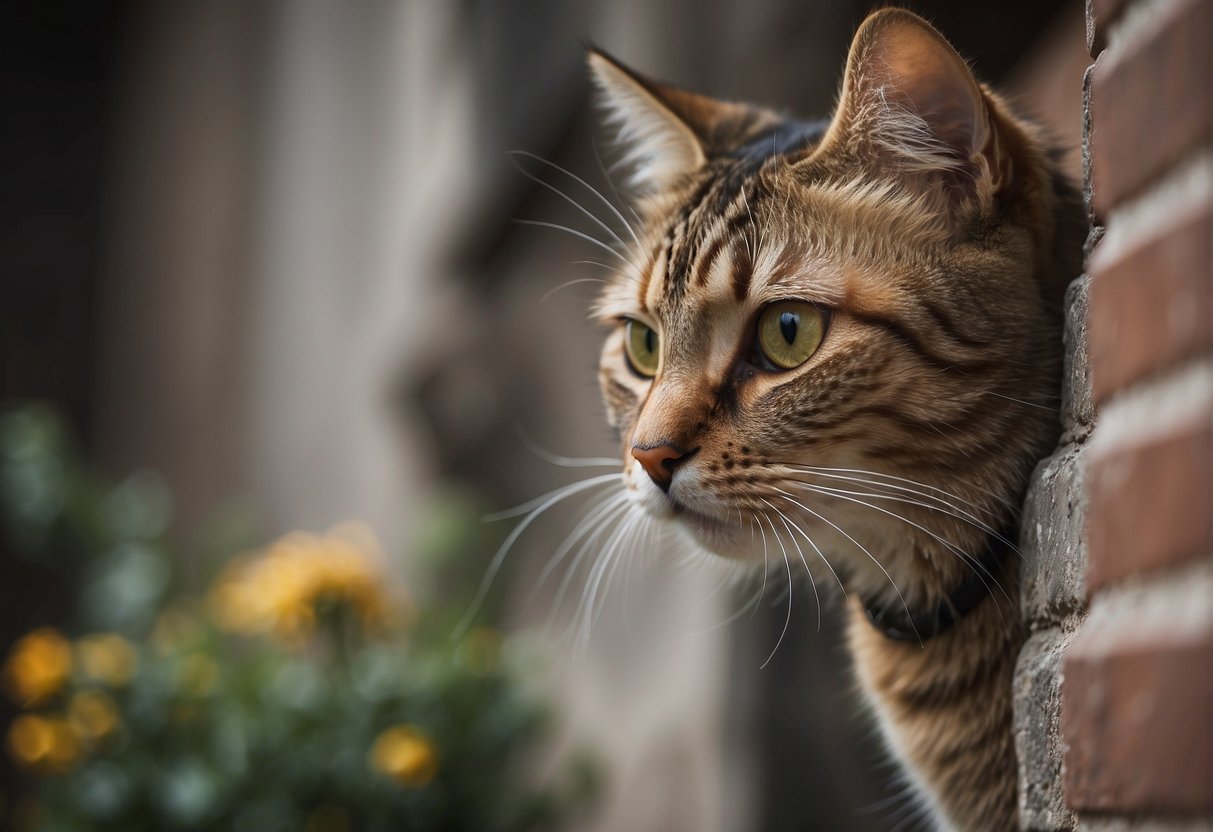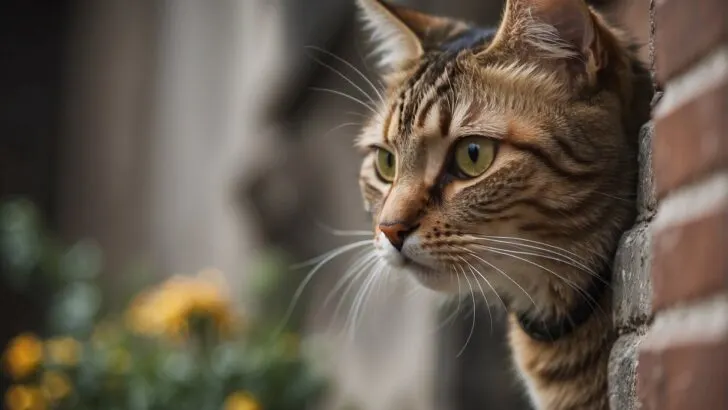Head pressing in cats is more than just a quirky behavior; it’s an action that can indicate serious health issues concerning your cat’s nervous system. If you’ve ever noticed your feline friend repeatedly and forcefully pushing their head against a wall or furniture, it’s not a sign of affection but a potential warning signal.
Instances like seeing a cat continually pressing its head into the corner of a sofa or relentlessly bumping its forehead against a hard bookshelf certainly warrant attention.

Recognizing this behavior is the first step to understanding and helping your cat. The symptoms aren’t always as obvious as you might think, and they can be confused with typical cat antics.
A cat who suddenly starts to press its head frequently, seems disoriented, or displays any change in reflexes might be giving you vital signs that it’s time for a vet visit.
Recognizing Head Pressing in Cats

Head pressing in cats is a behavior that requires your attention, as it can be a sign of a serious medical condition.
Identifying Symptoms
Symptoms of head pressing in cats can include your cat persistently pushing its head against walls or other hard objects without an obvious reason. You may also notice accompanying signs such as disorientation, pacing, circling, or a head tilt. Here’s a quick checklist:
- Persistent pressing of head against solid surfaces
- Disorientation: Appearing confused or lost in familiar surroundings
- Pacing or circling: Repeatedly walking in circles or back and forth
- Head tilt: Holding the head at an odd angle
Understanding Compulsive Behavior
Compulsive behavior in cats can manifest as repetitive, seemingly purposeless actions. In the case of head pressing, it is crucial to determine whether this action is driven by a compulsion as opposed to being a conscious, normal behavior.
Compulsions can arise from various underlying health issues and often warrant a consultation with a veterinarian.
Differentiating from Affectionate Behavior
It’s easy to confuse head pressing with bunting or head butting, behaviors cats use to show affection or to deposit pheromones. When a cat is bunting, they will typically rub their cheek, forehead, or sides against you or objects and appear content and engaged.
Contrast this with head pressing, where the motive is not to interact with their surroundings, but rather seems driven by an unseen discomfort.
Possible Causes Behind the Behavior
When you notice your cat persistently pressing its head against walls or furniture, it’s important to recognize that this could be symptomatic of a few serious health issues.
It’s a behavior that’s distinctly different from the affectionate head butting your feline friend usually exhibits, and it warrants a closer look at their health.
Neurological and Metabolic Disorders
Neurological and metabolic disorders in cats can lead to the concerning behavior of head pressing. For instance:
- Seizures can cause disorientation and unusual behavior, including head pressing.
- Metabolic Disorders: Conditions such as liver shunts can alter normal metabolic processes, leading to accumulation of toxins in the blood and affecting the brain, causing signs like head pressing.
- Prosencephalon Disease: This disease affects the forebrain and can disrupt a cat’s perception and behavior.
Infections and Poisoning
Various infections and cases of poisoning can also cause your cat to press its head against surfaces:
- Encephalitis: Inflammation of the brain, potentially due to infections like rabies, fungal infections, or toxoplasmosis, often leads to neurological symptoms such as head pressing.
- Poisoning: Ingesting toxic substances, including toxic plants or lead poisoning, will often result in neurological distress.
Be watchful for other symptoms like disorientation or changes in behavior, as these can accompany head pressing in cases of infection or poisoning.
Trauma and Vascular Diseases
Impact to the head or diseases affecting the blood vessels in the brain can lead to head pressing:
- Trauma: A blow to the head or a fall can cause head trauma, which may result in swelling or bleeding in the brain.
- Stroke: Just as in humans, a stroke can occur in cats and is often a result of a blood clot or broken blood vessel in the brain.
Diagnostic Procedures For Excessive Head Pressing
When you notice symptoms such as head pressing in your cat, it’s important to quickly pinpoint the root cause through proper diagnostic procedures. These tests help to determine the most effective course of treatment.
Laboratory and Imaging Tests
Your veterinarian will likely start with a Complete Blood Count (CBC) to check for signs of infection, inflammation, or anemia. Urinalysis helps evaluate the kidney function and detect potential metabolic diseases.
To examine the brain’s structure, Computed Tomography (CT) or Magnetic Resonance Imaging (MRI) may be performed, distinguishing between issues like tumors, fluid buildup, or injury. X-ray imaging can sometimes be utilized, although less detailed for neurological problems.
Lab tests on cerebrospinal fluid can reveal infections from fungal, bacterial, or parasitic causes.
- CBC & Urinalysis: Identifies infection, inflammation, metabolic condition.
- CT/MRI: Reveals structural brain abnormalities.
- X-rays: Assesses for injuries not visible externally.
Physical and Neurological Exams
A thorough Physical Exam can uncover signs of other health issues that might be related to the head pressing behavior. This includes checking for abnormalities in blood pressure and conducting an Eye Exam to assess for vision problems.
During a Neurological Exam, your vet will test reflexes and observe for behavioral changes to evaluate the nervous system. These exams are crucial as they help differentiate between neurological problems and other illnesses.
- Physical Exam: Assesses overall health and blood pressure.
- Eye Exam: Screens for visual impairment.
- Neurological Exam: Tests reflexes and behavioral responses.
Timely and accurate diagnosis is key to a positive prognosis. Identifying the cause of your cat’s head pressing is the first step towards getting the right treatments and giving your feline friend the best chance for recovery.
Treatment and Management
In addressing head pressing in cats, it’s essential to understand that treatment varies greatly depending on the underlying cause.
Your vet will provide a specific treatment plan tailored to your cat’s needs, which may include medical interventions, surgery, and supportive care to manage the condition effectively.
Medical and Surgical Interventions
If your cat’s head pressing is due to a medical condition such as liver disease, inflammation, or cancer, treatment may involve:
- Medications: These can control inflammation, treat liver disease, or address other specific conditions.
- Surgery: Necessary especially if brain tumors are the cause. It’s aimed to remove the tumor and alleviate pressure on the brain.
- Hospitalization: In some cases, immediate inpatient care is required to stabilize your cat’s condition.
Supportive Care and Prognosis
Alongside targeted treatments, providing supportive care is crucial for your cat’s wellbeing:
- Monitoring: Watch for signs of improvement or worsening symptoms like vomiting, incoordination, weakness, or blindness.
- Assistive Care: Help your cat with feeding and hydration if they’re experiencing difficulties.
- Comfort: Reduce stress and discomfort with a quiet, safe environment and plenty of love.
The prognosis for a cat with head pressing depends greatly on the underlying cause and the timeliness of intervention. Some conditions, like treatable inflammations, may have a positive outcome, while serious issues such as advanced cancer might have a guarded prognosis.

My name is James, and welcome to FAQCats!
Along with our team of cat owners, expert pet enthusiasts, and pet professionals, we aim to write engaging helpful, engaging content about cats. At FAQCats we strive to provide content that’s accurate and fun to read. Our team writes about everything related to cats; even the most complex of topics. Through extensive research and caring for our own fur-pals, we’re able to provide something cat owners worldwide will love. Have a look around, and leave us feedback anytime!

